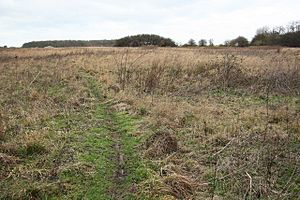Bullington Priory facts for kids
Bullington Priory was a special religious home located in Bullington, Lincolnshire, England. It was a type of monastery, a place where monks and nuns lived and prayed. This priory was part of the Gilbertine Order, which was the only religious order founded in England. It was dedicated to Saint Mary.
Contents
How Bullington Priory Started
Bullington Priory was founded as a "double house" between 1148 and 1154. This meant it had separate areas for both monks (called canons) and nuns. Simon, the son of William de Kyme, started the priory. He gave a piece of his land, some wood, and the churches of Bullington and Langton. He also gave them Hackthorn Mill.
Later, Simon's son, Philip de Kyme, added more gifts. He provided land in Faldingworth for seven canons. He also gave the churches of Spridlington and Winthorpe, and a share of land in Friskney. For the nuns, he gave 20 acres of land in Huttoft. This land helped provide clothing for the nuns' community. He also gave them the church of St. Albinus at Spridlington.
Another person, Alexander de Crevequer, also helped. He gave 52 acres of land in Hackthorn. He also allowed the priory to let 500 sheep graze on his land. He even gave them a small priory his father had built on an island called Tunstall.
Rules for the Priory
The rules for the Gilbertine Order were set by Saint Gilbert. These rules limited the number of people who could live at Bullington Priory. There could be no more than 100 nuns and lay sisters (women who helped with daily tasks). There could also be no more than 50 canons (monks) and lay brothers (men who helped with daily tasks).
Life at the Priory
Throughout the 1200s, the priory grew. The leaders of the priory, called the Prior and Prioress, continued to gain more land and churches. This helped the priory become stronger and more important in the area.
However, the priory faced hard times after the Black Death. This terrible sickness spread across Europe in the 1300s. By 1428, there were very few people left at Bullington and Spridlington. Because there were so few people, the church at Spridlington fell into disrepair and became a ruin.
The End of the Priory
Bullington Priory continued until 1538. At that time, the Prior, Prioress, nine canons, and fourteen nuns surrendered the priory. This meant they gave up the priory and its lands to the King. This was part of a larger event in England called the Dissolution of the Monasteries.
Important Records
Many important historical documents from Bullington Priory still exist today. These are known as the Bullington Series of charters. Charters are like old legal papers or agreements. Most of these valuable records are kept safe in the British Library in London.


